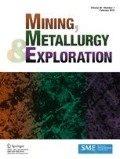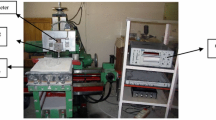Abstract
Specific energy (SE) is defined as the amount of work required to cut a unit volume of rock and is used to estimate the performance of excavation machines. Generally, the SE value is produced from full-scale or small-scale rock cutting tests. However, these tests require expensive equipment and experienced personnel, and the testing procedure is time consuming and impractical. Therefore, for estimation of SE, this study aimed to find a solution to estimate SE using rock mechanics test results and Bond work index values (BWi), which can be produced in a more practical, less time-consuming manner and with inexpensive test equipment. Small-scale rock cutting, rock mechanics and Bond work index tests were carried out on seven rock samples, which can be grouped into two different type of rocks: marble and travertine. In addition, the instantaneous cutting rates (ICR) of a selected roadheader were calculated using SE values. Rock mechanics tests performed in this study were uniaxial compressive strength (UCS), Brazilian tensile strength (BTS), ultrasonic velocity (Vp), Schmidt rebound hardness (RL), corrected point load index (Is(50)) and density (ρ). The simple regression method was used to estimate SE from rock properties and BWi. As a result of this simple regression, a significant and highest correlation was found between SE vs. UCS and Is(50). A good correlation was found between SE vs. BTS, RL and BWi values. A moderate correlation was found between SE vs. Vp and ρ.











Similar content being viewed by others
References
Fowell RJ, McFeat-Smith I (1976) Factors influencing the cutting performance of a selective tunneling machine. In: Tunneling’76. Inst of Mining and Metallurgy, London, UK, pp 3–10
McFeat-Smith I, Fowell RJ (1977) Correlation of rock properties and the cutting performance of tunnelling machines. In: Conference on rock engineering. New Castle upon Tyne, UK, pp 581–602
McFeat-Smith I, Fowell RJ (1979) The selection and application of roadheaders for rock tunneling. In: Proceedings of the 4th rapid excavation and Tunnelling conference. Atlanta, USA, pp 261–280
Rostami J, Ozdemir L, Neil DM (1994) Performance prediction: a key issue in mechanical hard rock mining. Min Eng 46(11):1263–1267
Bilgin N, Yazici S, Eskikaya S (1996) A model to predict the performance of roadheaders and impact hammers in tunnel drivages. In: Proceedings of ISRM international symposium-Eurock’96. Turin, Italy, pp 715–720
Bilgin N, Balci C, Eskikaya S, Ergunalp D (1997) Full-scale and small-scale cutting tests for equipment selection in a celestite mine. In: 6th international symposium on mine planning and equipment selection. CRC, London, pp 387–392. https://doi.org/10.1201/9781003078166
Bilgin N, Kuzu C, Eskikaya S, Özdemir L (1997) Cutting performance of jack hammers and roadheaders in Istanbul metro drivages. In: World tunnel congress. Austria, Vienna, pp 455–460
Çopur H, Tunçdemir H, Bilgin N, Dinçer T (2001) Specific energy as a criterion for the use of rapid excavation systems in Turkish mines. Min Technol 110(3):149–157. https://doi.org/10.1179/mnt.2001.110.3.149
Bilgin N, Dinçer T, Copur H (2002) The performance prediction of impact hammers from Schmidt hammer rebound values in Istanbul metro tunnel drivages. Tunn Undergr Space Technol 17:237–247. https://doi.org/10.1016/S0886-7798(02)00009-3
Altindag R (2003) Correlation of specific energy with rock brittleness concepts on rock cutting. J South Afr Inst Min Metall 103:163–171
Copur H, Bilgin N, Tuncdemir H, Balci C (2003) A set of indices based on indentation tests for assessment of rock cutting performance and rock properties. J South Afr Inst Min Metall 103(9):589–600
Balci C, Demircin MA, Copur H, Tuncdemir H (2004) Estimation of optimum specific energy based on rock properties for assessment of roadheader performance. J South Afr Inst Min Metall 104(11):633–641
Öztürk CA, Nasuf E, Bilgin N (2004) The assessment of rock cutability, and physical and mechanical rock properties from a texture coefficient. J South Afr Inst Min Metall 104(7):397–402
Bilgin N, Demircin MA, Copur H, Balci C, Tuncdemir H, Akcin N (2006) Dominant rock properties affecting the performance of conical picks and the comparison of some experimental and theoretical results. Int J Rock Mech Min Sci 43(1):139–156. https://doi.org/10.1016/j.ijrmms.2005.04.009
Tiryaki B, Dikmen AC (2006) Effects of rock properties on specific cutting energy in linear cutting of sandstones by picks. Rock Mech Rock Eng 39(2):89–120
Tiryaki B (2006) Evaluation of the indirect measures of rock brittleness and fracture toughness in rock cutting. J South Afr Inst Min Metall 106(6):407–423
Balci C, Bilgin N (2007) Correlative study of linear small and full-scale rock cutting tests to select mechanized excavation machines. Int J Rock Mech Min Sci 44(3):468–476. https://doi.org/10.1016/j.ijrmms.2006.09.001
Tumac D, Bilgin N, Feridunoglu C, Ergin H (2007) Estimation of rock cuttability from shore hardness and compressive strength properties. Rock Mech Rock Eng 40(5):477–490
Copur H (2010) Linear stone cutting tests with chisel tools for identification of cutting principles and predicting performance of chain saw machines. Int J Rock Mech Min Sci 47(1):104–120. https://doi.org/10.1016/j.ijrmms.2009.09.006
Copur H, Balci C, Tumac D, Bilgin N (2011) Field and laboratory studies on natural stones leading to empirical performance prediction of chain saw machines. Int J Rock Mech Min Sci 48(2):269–282. https://doi.org/10.1016/j.ijrmms.2010.11.011
Copur H, Balci C, Bilgin N, Tumac D, Avunduk E (2012) Predicting cutting performance of chisel tools by using physical and mechanical properties of natural stones. In: Proceedings of ISRM International Symposium, EUROCK’2012, Stockholm, Sweden
Dogruoz C, Bolukbasi N (2014) Effect of cutting tool blunting on the performances of various mechanical excavators used in low- and medium-strength rocks. Bull Eng Geol Environ 73:781–789
Comakli R, Kahraman S, Balci C (2014) Performance prediction of roadheaders in metallic ore excavation. Tunn Undergr Space Technol 40:38–45. https://doi.org/10.1016/j.tust.2013.09.009
Bilgin N, Copur H, Balci C (2014) Mechanical excavation in mining and civil industries. CRC, Boca Raton
Dursun AE, Gokay MK (2016) Cuttability assessment of selected rocks through different brittleness values. Rock Mech Rock Eng 49(4):1173–1190. https://doi.org/10.1007/s00603-015-0810-2
He X, Xu C (2015) Specific energy as an index to identify the critical failure mode transition depth in rock cutting. Rock Mech Rock Eng 49(4):1461–1478. https://doi.org/10.1007/s00603-015-0819-6
Tumac D, Copur H, Balci C, Er S, Avunduk E (2018) Investigation into the effects of textural properties on cuttability performance of a chisel tool. Rock Mech Rock Eng 51(4):1227–1248
Deniz V, Ozdag H (2003) A new approach to Bond grindability and work index: dynamic elastic parameters. Min Eng 16(3):211–217. https://doi.org/10.1016/S0892-6875(02)00318-7
Özkahraman H (2005) A meaningful expression between Bond work index, grindability index and friability value. Min Eng 18(10):1057–1059. https://doi.org/10.1016/j.mineng.2004.12.016
Ozer U, Cabuk E (2007) Relationship between Bond work index and rock parameters. Ist U J Earth Sci Rev 20(1):43–49
Haffez GSA (2012) Correlation between work index and mechanical properties of some Saudi ores. Mater Test 54(2):108–112. https://doi.org/10.3139/120.110302
Aras A, Ozkan A, Aydogan S (2012) Correlations of Bond and breakage parameters of some ores with the corresponding point load index. Part Part Syst Charact 29(3):204–210. https://doi.org/10.1002/ppsc.201100019
Chandar KR, Deo SN, Baliga AJ (2016) Prediction of Bond's work index from field measurable rock properties. Int J Miner Process 157:134–144. https://doi.org/10.1016/j.minpro.2016.10.006
Ulusay R, Hudson JA (2007) The complete ISRM suggested methods for rock characterization, testing and monitoring: 1974–2006. International Society for Rock Mechanics. Commission on testing methods. Springer, London
Bond FC (1961) Crushing and grinding calculations-part 1. Br Chem Eng 6:378–385
Copur H, Rostami J, Ozdemir L, Bilgin N (1997) Studies on performance prediction of roadheaders. In: Proceedings of the 4th international symposium on mine mechanization and automation, 1997. Brisbane, Qld., Australia, pp 4A1–4A7
Copur H, Ozdemir L, Rostami J (1998) Roadheader applications in mining and tunneling industries. Min Eng 50(3):38–42
Bilgin N, Seyrek T, Shahriar K (1988) Golden Horn clean-up contributes valuable data. Tunn Tunnel 20:41–44
Bilgin N, Dinçer T, Copur H, Erdogan M (2004) Some geological and geotechnical factors affecting the performance of a roadheader in an inclined tunnel. Tunn Undergr Space Technol 19:629–636. https://doi.org/10.1016/j.tust.2004.04.004
Gehring KH (1989) A cutting comparison. Tunn Tunnel 21(11):27–30
Thuro K, Plinninger R (1999) Roadheader excavation performance-geological and geotechnical influences. In: 9th ISRM congress. France, Paris, pp 1241–1244
Ocak I, Bilgin N (2010) Comparative studies on the performance of a roadheader, impact hammer and drilling and blasting method in the excavation of metro station tunnels in Istanbul. Tunn Undergr Space Technol 25(2):181–187
Ebrahimabadi A, Goshtasbi K, Shahriar K, Cheraghi Seifabad M (2011) A model to predict the performance of roadheaders based on the rock mass brittleness index. J South Afr Inst Min Metall 111:355–364
Kahraman E, Kahraman S (2015) The performance prediction of roadheaders from easy testing methods. Bull Eng Geol Environ 75:1585–1596. https://doi.org/10.1007/s10064-015-0801-2
Comakli R (2019) Performance of roadheaders in low strength pyroclastic rocks, a case study of cold storage caverns in Cappadocia. Tunn Undergr Space Technol 89:179–188. https://doi.org/10.1016/j.tust.2019.04.00
Acknowledgements
The authors are indebted to Dr. Gürsel Kansun for his valuable contributions.
Author information
Authors and Affiliations
Corresponding author
Ethics declarations
Conflict of Interest
The authors declare that they have no conflict of interest.
Additional information
Publisher’s Note
Springer Nature remains neutral with regard to jurisdictional claims in published maps and institutional affiliations.
Rights and permissions
About this article
Cite this article
Özşen, H., Dursun, A.E. & Aras, A. Estimation of Specific Energy and Evaluation of Roadheader Performance Using Rock Properties and Bond Work Index. Mining, Metallurgy & Exploration 38, 1923–1932 (2021). https://doi.org/10.1007/s42461-021-00454-3
Received:
Accepted:
Published:
Issue Date:
DOI: https://doi.org/10.1007/s42461-021-00454-3




